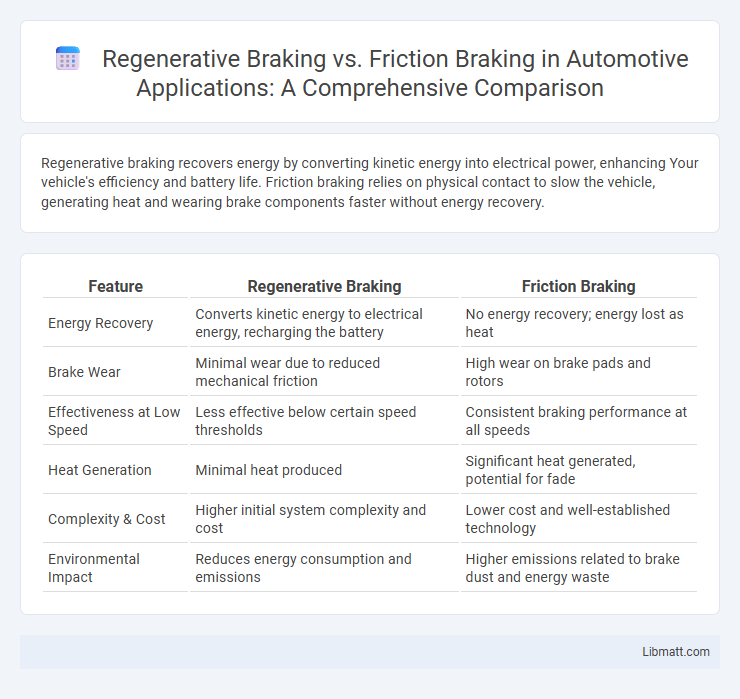Regenerative braking recovers energy by converting kinetic energy into electrical power, enhancing Your vehicle's efficiency and battery life. Friction braking relies on physical contact to slow the vehicle, generating heat and wearing brake components faster without energy recovery.
Table of Comparison
| Feature | Regenerative Braking | Friction Braking |
|---|---|---|
| Energy Recovery | Converts kinetic energy to electrical energy, recharging the battery | No energy recovery; energy lost as heat |
| Brake Wear | Minimal wear due to reduced mechanical friction | High wear on brake pads and rotors |
| Effectiveness at Low Speed | Less effective below certain speed thresholds | Consistent braking performance at all speeds |
| Heat Generation | Minimal heat produced | Significant heat generated, potential for fade |
| Complexity & Cost | Higher initial system complexity and cost | Lower cost and well-established technology |
| Environmental Impact | Reduces energy consumption and emissions | Higher emissions related to brake dust and energy waste |
Introduction to Braking Systems
Regenerative braking systems convert kinetic energy into electrical energy, improving energy efficiency in electric and hybrid vehicles by storing energy in the battery. Friction braking relies on mechanical components that apply pressure to brake pads and rotors, generating heat to slow the vehicle. Regenerative braking enhances fuel economy and reduces brake wear compared to traditional friction braking methods.
What Is Regenerative Braking?
Regenerative braking captures the kinetic energy typically lost as heat during deceleration and converts it into electrical energy to recharge the vehicle's battery, enhancing overall energy efficiency. Unlike friction braking, which relies on brake pads pressing against rotors to create friction and slow the vehicle while dissipating energy as heat, regenerative braking uses the electric motor as a generator to slow the vehicle and recover energy. Your vehicle equipped with regenerative braking benefits from extended driving range and reduced wear on traditional brake components.
How Friction Braking Works
Friction braking operates by applying brake pads or shoes against a vehicle's rotating wheels or discs, converting kinetic energy into heat through friction. This process slows the vehicle by physically resisting wheel movement, with energy dissipated as thermal energy, requiring robust materials to withstand high temperatures. Unlike regenerative braking, friction braking does not recover energy but remains essential for emergency stops and low-speed maneuvers where regenerative systems are less effective.
Key Differences Between Regenerative and Friction Braking
Regenerative braking converts kinetic energy into electrical energy, which is stored in the battery for later use, improving overall energy efficiency in electric and hybrid vehicles. Friction braking relies on mechanical force to create friction between brake pads and rotors, generating heat to slow down the vehicle, leading to faster wear and less energy recovery. Regenerative braking systems reduce brake pad wear and enhance vehicle range, while friction brakes provide reliable, immediate stopping power regardless of battery charge or system condition.
Energy Efficiency Comparison
Regenerative braking captures kinetic energy and converts it into electrical energy, enhancing energy efficiency by reducing overall energy loss. Friction braking dissipates kinetic energy as heat, leading to significant energy waste and reduced efficiency. Electric and hybrid vehicles benefit from regenerative braking systems, achieving up to 70% energy recovery compared to conventional friction braking.
Impact on Vehicle Maintenance
Regenerative braking significantly reduces wear on brake pads and discs by using the electric motor to slow the vehicle, decreasing the frequency of brake replacements and maintenance costs. In contrast, friction braking relies on physical contact between brake pads and rotors, causing more heat and wear that necessitates regular inspection and part replacement. Vehicles equipped with regenerative braking systems typically experience longer brake system longevity and lower overall maintenance expenses.
Environmental Benefits and Drawbacks
Regenerative braking reduces environmental impact by capturing kinetic energy and converting it to electrical energy, thereby decreasing fuel consumption and lowering greenhouse gas emissions. Unlike friction braking, it generates less brake dust, a pollutant harmful to air quality and human health. Your vehicle benefits from extended brake component life, but regenerative systems require more complex and resource-intensive manufacturing processes.
Performance in Various Driving Conditions
Regenerative braking excels in urban and stop-and-go traffic by converting kinetic energy into electrical energy, improving efficiency and extending electric vehicle range. Friction braking delivers consistent and reliable stopping power in high-speed or emergency situations, where regenerative braking alone may be insufficient. Your vehicle's overall braking performance benefits from the combined use of both systems, optimizing energy recovery and safety across diverse driving conditions.
Applications in Modern Vehicles
Regenerative braking is widely applied in hybrid and electric vehicles to improve energy efficiency by converting kinetic energy into electrical energy for battery storage. Friction braking remains essential for traditional internal combustion engine vehicles and serves as a reliable backup in electric vehicles to provide immediate stopping power and control. Your vehicle's braking system often combines both technologies to enhance performance, safety, and energy conservation.
Future Trends in Braking Technology
Regenerative braking technology is rapidly advancing with integration of smarter energy recovery systems and improved battery storage, making it a key component in future electric and hybrid vehicles. Friction braking continues to evolve with lightweight materials and low-dust brake pads that enhance durability and reduce maintenance costs. Your vehicle's braking efficiency will benefit from the combination of these innovations, providing safer and more energy-efficient driving experiences.
regenerative braking vs friction braking Infographic

 libmatt.com
libmatt.com